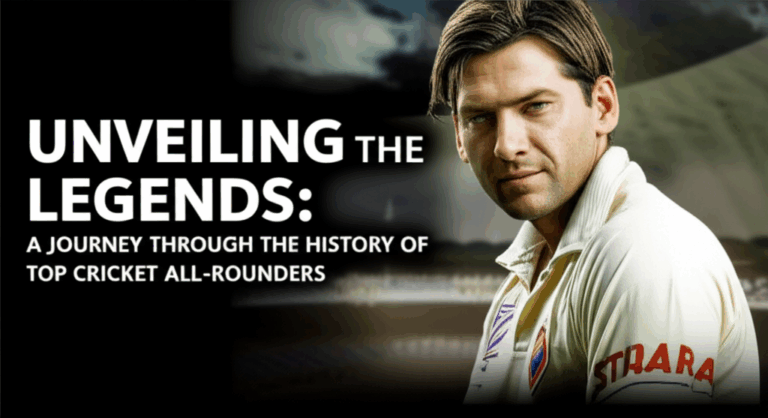
Cricket, often described as a gentleman’s game, has its fair share of legends, myths, and remarkable stories. Among these, all-rounders stand out as the gems of the sport. They are unique athletes, capable of both batting and bowling, often turning the tide of a match single-handedly. As we embark on this journey through the history of top cricket all-rounders, we’ll explore their contributions, the evolution of their roles, and the impact they’ve had on cricketing history. Whether you’re a seasoned cricket enthusiast or new to the game, this article promises to unveil the legends who have shaped the world of cricket, offering insights that will deepen your appreciation for these exceptional players.
In this article, you will discover the defining characteristics of all-rounders, their historical significance, and the skills that set them apart. We’ll delve into the profiles of some of the greatest all-rounders, analyzing their styles and contributions. You’ll also learn about the importance of all-rounders in modern cricket and the practical applications of their skills in various formats. So, buckle up as we explore the illustrious history of cricket’s finest all-rounders!
Understanding All-Rounders
What exactly defines an all-rounder? In cricket, an all-rounder is a player who excels in both batting and bowling. They are the Swiss Army knives of the team, providing versatility and balance. The role of an all-rounder can vary greatly depending on the format of the game—Test, One-Day International (ODI), or Twenty20 (T20). However, their core attribute remains the same: the ability to contribute significantly in multiple areas of the game.
The Evolution of All-Rounders
Historically, the role of an all-rounder has evolved significantly. In the early days of cricket, players often had to be proficient in multiple skills due to the limited number of specialized players. However, as the game evolved, so did the specialization of roles. In the 20th century, we began to see the rise of dedicated all-rounders, such as Sir Garfield Sobers and Kapil Dev, who not only contributed with bat and ball but also brought charisma and flair to the game.
Key Components of an All-Rounder
Being an all-rounder is not just about having the ability to bat and bowl. There are several key components that make a successful all-rounder.
1. Versatility
All-rounders must adapt their skills to various formats of the game. For instance, a successful T20 all-rounder, like Andre Russell, may focus on explosive batting and effective bowling variations, while a Test all-rounder, like Ben Stokes, may emphasize consistency and technique.
2. Fitness
Given the demands of playing both roles, fitness is paramount. All-rounders often endure long hours on the field, so maintaining peak physical condition is essential for their performance.
3. Mental Toughness
The ability to handle pressure is crucial. All-rounders often find themselves in high-stakes situations where their contributions can determine the outcome of a match. Mental resilience allows them to thrive under pressure.
4. Skill Development
All-rounders continuously refine their skills. This includes not only batting and bowling techniques but also fielding, as being sharp in the field can significantly impact a game’s outcome.
Benefits and Importance of All-Rounders
All-rounders play a pivotal role in shaping the dynamics of a cricket team. Here are some of the benefits they bring:
- Team Balance: They provide a perfect balance to the team, allowing for flexibility in team selection and strategy.
- Match-Winning Ability: Their dual skills often make them match-winners, capable of turning games around with remarkable performances.
- Depth in Batting and Bowling: All-rounders add depth to both batting and bowling line-ups, which is especially valuable in limited-overs formats.
- Leadership: Many all-rounders possess strong leadership qualities, often becoming captains or influential figures within the squad.
Profiles of Legendary All-Rounders
Now, let’s take a dive into some of the most iconic all-rounders in cricket history. Each of these players has left an indelible mark on the sport.
Sir Garfield Sobers
Regarded as one of the greatest all-rounders of all time, Sir Garfield Sobers revolutionized the role. He was a left-handed batsman who could score runs at will and a left-arm bowler capable of taking wickets with ease. His career spanned from 1954 to 1974, during which he amassed over 8,000 runs and took more than 200 wickets in Test cricket. Sobers was known for his extraordinary ability to change a game single-handedly, making him a true legend of the sport.
Kapil Dev
Kapil Dev led India to its first World Cup victory in 1983, a moment that changed the landscape of Indian cricket forever. As a fast-bowling all-rounder, he scored over 5,000 runs and took 434 wickets in ODIs. His ability to perform under pressure and his explosive batting style made him a fan favorite. Kapil’s contributions to Indian cricket continue to inspire generations.
Imran Khan
Another iconic figure, Imran Khan, was not only an exceptional cricketer but also a charismatic leader. He captained Pakistan to its first World Cup win in 1992. As an all-rounder, he scored over 3,700 runs and took 362 wickets in Test cricket. Imran’s blend of fierce competitiveness and sportsmanship made him a role model for aspiring cricketers.
Jacques Kallis
Jacques Kallis is often hailed as one of the greatest all-rounders in the history of cricket. With over 10,000 runs and 300 wickets in both Test and ODI formats, Kallis redefined consistency and excellence. His technique and ability to perform in high-stakes situations make him a standout in the annals of cricket history.
Ben Stokes
In contemporary cricket, Ben Stokes has emerged as a leading all-rounder. His performances in the 2019 World Cup and the Ashes series showcased his ability to perform under pressure. Stokes combines aggressive batting with effective bowling, making him a vital player for England. His dynamic approach and resilience have earned him accolades and admiration from fans worldwide.
Practical Applications of All-Rounders in Modern Cricket
In today’s fast-paced cricket environment, the role of all-rounders has become even more crucial. Let’s explore how they impact modern cricket.
1. Strategic Flexibility
All-rounders provide teams with strategic options. Coaches can adjust team combinations based on the conditions and opposition, allowing for more tailored game plans. This flexibility can be the difference in tightly contested matches.
2. Adaptation to Format Changes
With the rise of T20 cricket, all-rounders have adapted their skills to meet the demands of shorter formats. Players like Hardik Pandya and Andre Russell exemplify this transition, combining power hitting with effective bowling to dominate matches.
3. Leadership Roles
Many all-rounders take on leadership roles within their teams. Their experience in handling pressure situations makes them valuable assets, often leading to successful team dynamics.
4. Fan Engagement
All-rounders often have a unique ability to connect with fans. Their versatility and thrilling performances make them crowd favorites, enhancing the overall spectator experience.
Frequently Asked Questions
What is an all-rounder in cricket?
An all-rounder in cricket is a player who excels in both batting and bowling. They contribute significantly in both areas, making them invaluable assets to their teams. Their ability to perform multiple roles provides strategic options for coaches and enhances the team’s overall performance.
Who are some of the greatest all-rounders in cricket history?
Some of the greatest all-rounders include Sir Garfield Sobers, Kapil Dev, Imran Khan, Jacques Kallis, and Ben Stokes. Each of these players has made significant contributions to the sport and has left a lasting legacy due to their exceptional skills in both batting and bowling.
Why are all-rounders important in modern cricket?
All-rounders are crucial in modern cricket as they provide teams with flexibility and depth in both batting and bowling. Their ability to adapt to various formats and perform under pressure makes them essential in strategic planning and execution during matches.
How has the role of all-rounders evolved over time?
The role of all-rounders has evolved from being versatile players who fulfilled multiple roles to specialized athletes who excel in both batting and bowling. As the game has progressed, the expectations for all-rounders have increased, with players now needing to adapt their skills to different formats and conditions.
What skills should a successful all-rounder possess?
A successful all-rounder should possess versatility, fitness, mental toughness, and strong skill development in both batting and bowling. They must be able to perform under pressure and continually refine their abilities to stay relevant in the ever-evolving game of cricket.
How can aspiring cricketers become all-rounders?
Aspiring cricketers can become all-rounders by developing their skills in both batting and bowling. It’s important to focus on fitness, mental resilience, and adaptability to different playing conditions. Regular practice, training, and participating in competitive matches will help them refine their skills and gain experience.
Conclusion
As we conclude our journey through the rich history of cricket all-rounders, it’s clear that these players are not just integral to their teams but also to the very fabric of the game. From the legendary performances of Sir Garfield Sobers to the contemporary brilliance of Ben Stokes, all-rounders have consistently showcased their unique ability to influence matches and inspire fans. Their versatility, resilience, and leadership qualities make them indispensable in cricket today.
Now that you’ve explored the legends and the significance of all-rounders, I encourage you to watch a match, focusing on the all-rounders’ contributions. Their performances can be the catalyst for unforgettable moments in cricket. Engage with your friends about their favorite all-rounders and share what makes them stand out. Remember, the next time you watch a game, you’re not just witnessing a match; you’re watching history in the making!






